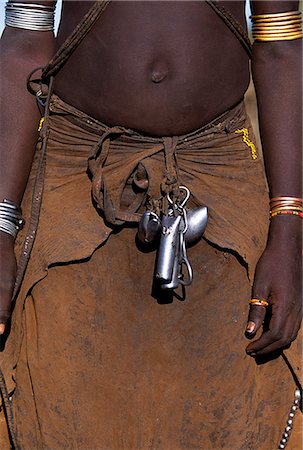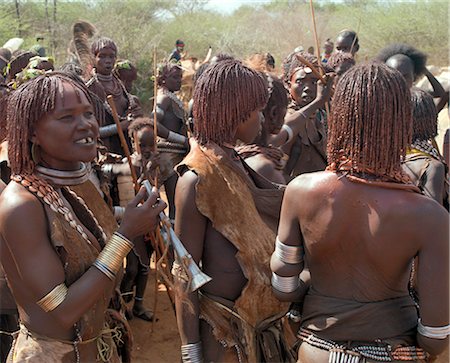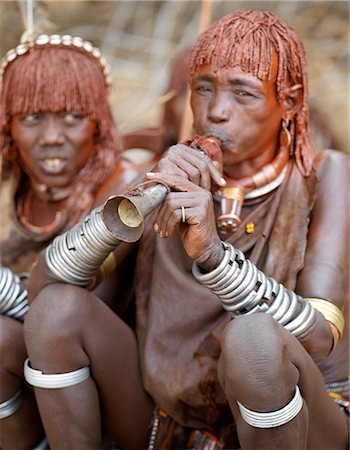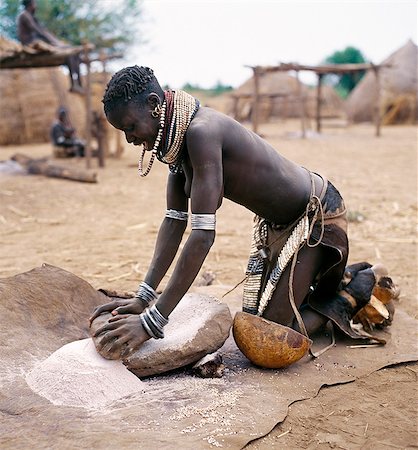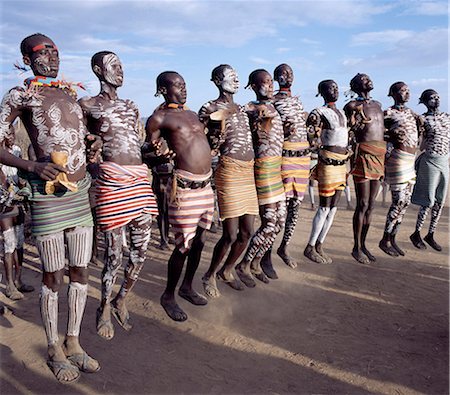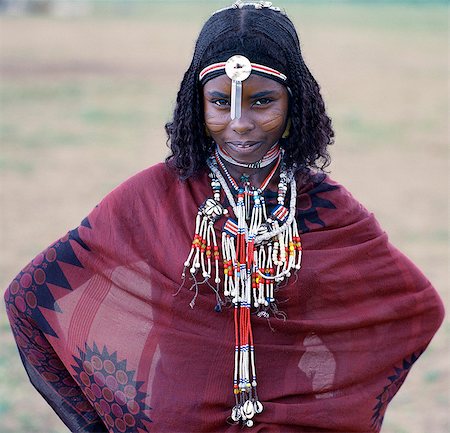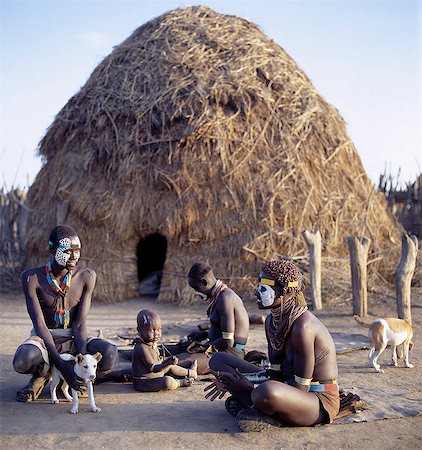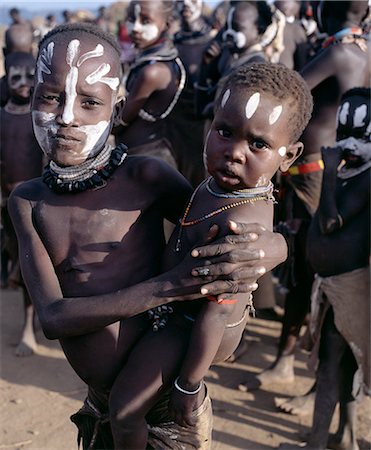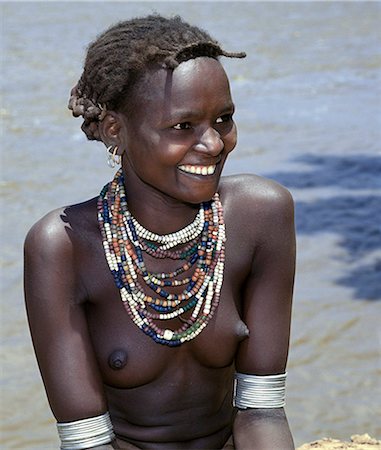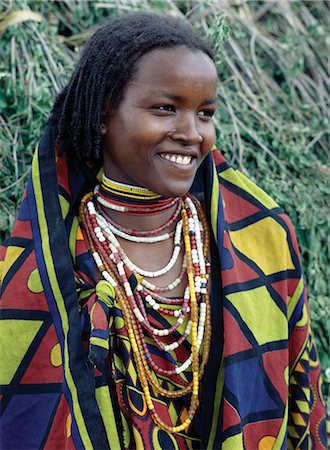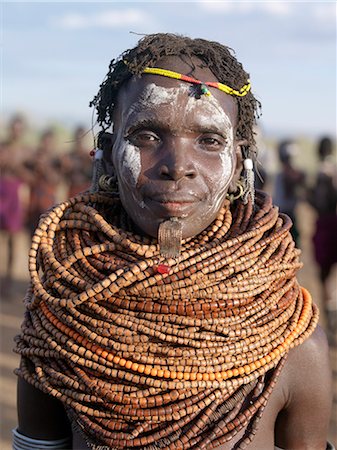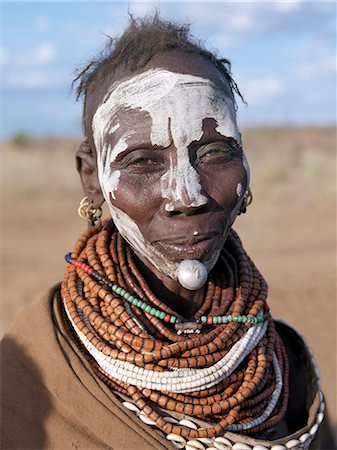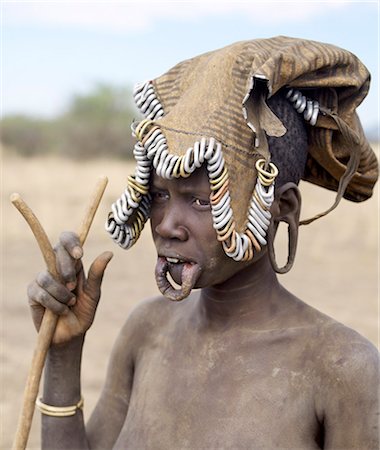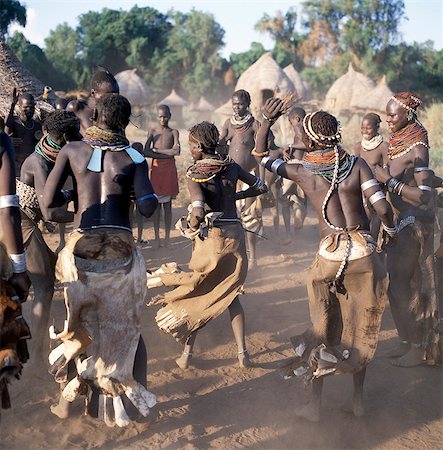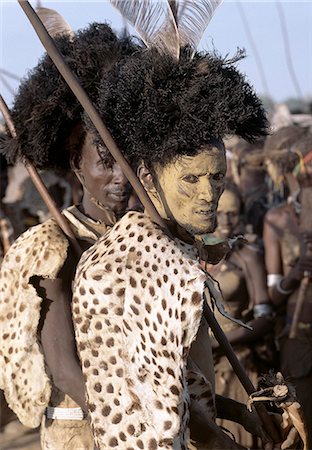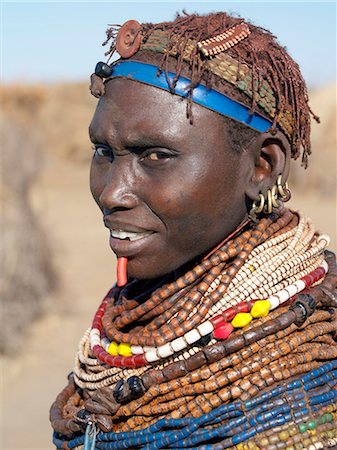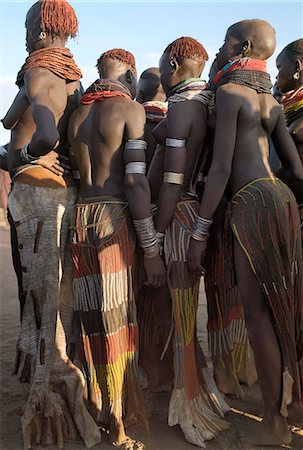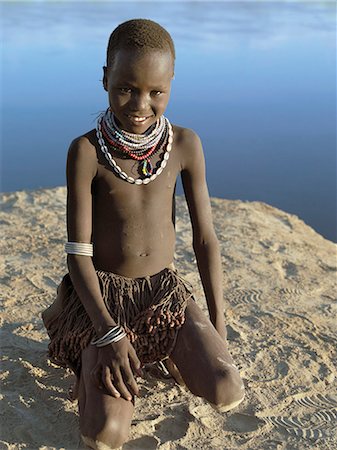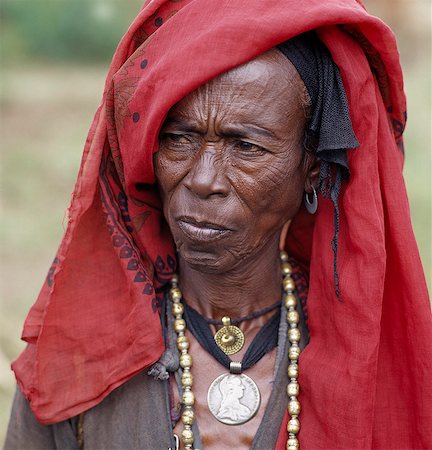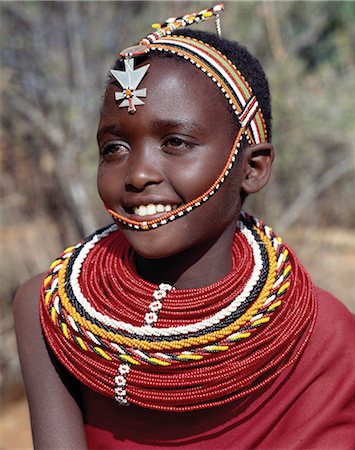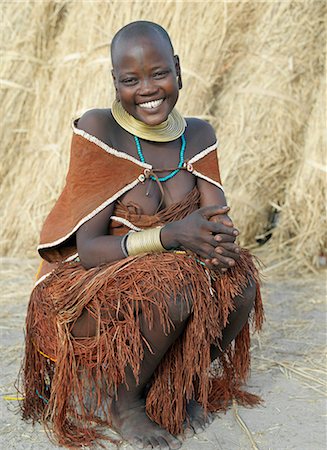-
A Karo woman with her face painted in preparation for a dance in the village of Duss. A small Omotic tribe related to the Hamar, who live along the banks of the Omo River in southwestern Ethiopia, the Karo are renowned for their elaborate body painting using white chalk, crushed rock and other natural pigments. She is wearing a goatskin apron and carries a leather belt decorated with cowrie shells
Rights-Managed
-
A Karo women stands in the doorway to her hut in the village of Duss. A small Omotic tribe related to the Hamar, who live along the banks of the Omo River in southwestern Ethiopia, the Karo are renowned for their elaborate body painting using white chalk, crushed rock and other natural pigments. In addition to painting her face she has decorated her body with whorls of goat hair tied by leather co
Rights-Managed
-
A young Karo girl in the doorway of her hut in the village of Duss. A small Omotic tribe related to the Hamar,who live along the banks of the Omo River in southwestern Ethiopia,the Karo are renowned for their elaborate body painting using white chalk,crushed rock and other natural pigments.
Rights-Managed
-
A Karo woman wears an elaborate headdress made from the wing-cases of beetles and a cape of calf skin fringed with cowrie shells. A small Omotic tribe related to the Hamar,who live along the banks of the Omo River in southwestern Ethiopia,the Karo are renowned for their elaborate body painting using white chalk,crushed rock and other natural pigments.
Rights-Managed
-
A Karo woman wears an elaborate headdress made from the wing-cases of beetles and a cape of calf skin fringed with cowrie shells. A small Omotic tribe related to the Hamar,who live along the banks of the Omo River in southwestern Ethiopia,the Karo are renowned for their elaborate body painting using white chalk,crushed rock and other natural pigments.
Rights-Managed
-
A Nyangatom woman wears multiple layers of beads in necklaces, an elaborately beaded calfskin skirt and metal bracelets, amulets and anklets. She is standing beside a temporary beehive construction of sticks, grass and leaves built to provide shade for her goats. The Nyangatom or Bume are a Nilotic tribe of semi-nomadic pastoralists who live along the banks of the Omo River in south western Ethio
Rights-Managed
-
A Karo woman sits with child. A small Omotic tribe related to the Hamar,who live along the banks of the Omo River in southwestern Ethiopia,the Karo are renowned for their elaborate body painting using white chalk,crushed rock and other natural pigments. Typically for a Karo woman,the mother has ochred her hair in tight ringlets and has a ring through her bottom lip.
Rights-Managed
-
A Dassanech woman winnows grain by pouring it from her metal tin and letting it fall onto a calfskin. Much the largest of the tribes in the Omo Valley numbering around 50,000,the Dassanech (also known as the Galeb,Changila or Merille) and Nilotic pastoralists and agriculturalists.
Rights-Managed
-
An elder of the Karo tribe sits with his wife and child. A small Omotic tribe related to the Hamar,who live along the banks of the Omo River in southwestern Ethiopia,the Karo are renowned for their elaborate body painting using white chalk,crushed rock and other natural pigments. This man also has a clay hairdo typical of tribal elders. Like most adult males he carries a rifle.
Rights-Managed
-
A young Dassanech girl wears a leather skirt,metal bracelets and amulets and layers of bead necklaces. Much the largest of the tribes in the Omo Valley numbering around 50,000,the Dassanech (also known as the Galeb,Changila or Merille) are Nilotic pastoralists and agriculturalists.
Rights-Managed
-
A young Nyangatom woman carries her baby on her hip in an elaborately braided papoose. Her hair has been reddened with a mixture of ochre and animal fat. Typical of her tribe, she wears a calfskin skirt, multiple layers of bead necklaces and metal bracelets and amulets. The Nyangatom or Bume are a Nilotic tribe of semi nomadic pastoralists who live along the banks of the Omo River in south western
Rights-Managed
-
A Nyangatom woman stands with her baby on her hip beside her grass hut in his temporary camp. Nyangatom married women wear elaborately beaded skirts which reach the ground at the back and often have panels of different coloured calkfskin sewn into the tail The Nyangatom or Bume are a Nilotic tribe of semi nomadic pastoralists who live along the banks of the Omo River in south western Ethiopia.
Rights-Managed
-
Two young Karo girls stand in front of the massive trunk of a fig tree. A small Omotic tribe related to the Hamar,who live along the banks of the Omo River in southwestern Ethiopia,the Karo are renowned for their elaborate body painting using white chalk,crushed rock and other natural pigments.
Rights-Managed
-
A young Dassanech girl wears a leather skirt,metal bracelets and amulets and layers of bead necklaces. A long leather strap decorated with cowrie shells hangs down her back. Much the largest of the tribes in the Omo Valley numbering around 50,000,the Dassanech (also known as the Galeb,Changila or Merille) are Nilotic pastoralists and agriculturalists.
Rights-Managed
-
A Mursi woman wearing a large clay lip plate. Shortly before marriage, a girls lower lip will be pierced and progressively stretched over a year or so. The size of the lip plate often determines the quantum of the bride price. They live in a remote area of southwest Ethiopia along the Omo River, the country's largest river.
Rights-Managed
-
A Mursi woman wearing a large wooden lip plate. Shortly before marriage, a girls lower lip will be pierced and progressively stretched over a year or so. The size of the lip plate often determines the quantum of the bride price. They live in a remote area of southwest Ethiopia along the Omo River.
Rights-Managed
-
Shaded from the hot sun, a Karo woman grinds sorghum using large flat stones.It is customary for females of the tribe when in their teens to make a small hole in the flesh below their lower lips into which they put an ornament, this woman has used a small nail. Numerous heavy metal bracelets are worn by married womenThe Karo are a small tribe living in three main villages along the lower reaches o
Rights-Managed
-
A pregnant Nyangatom woman in traditional attire outside her neatly thatched home.The Nyangatom are one of the largest tribes and arguably the most warlike people living along the Omo River in Southwest Ethiopia.
Rights-Managed
-
An elder of the Karo tribe,a small Omotic tribe related to the Hamar,who live along the banks of the Omo River in southwestern Ethiopia. The Karo are renowned for their elaborate body painting using white chalk,crushed rock and other natural pigments. This man also has a clay hairdo typical of tribal elders. Like most adult males he carries a rifle.
Rights-Managed
-
A Hamar woman dances around cattle while she blows a tin trumpet at a Jumping of the Bull ceremony.The Hamar are semi nomadic pastoralists of Southwest Ethiopia whose women wear striking traditional dress and style their red ochred hair mop fashion.The Jumping of the Bull ceremony is a rite of passage for young men.
Rights-Managed
-
Hamar women dance at a Jumping of the Bull ceremony.The Hamar are semi nomadic pastoralists of Southwest Ethiopia whose women wear striking traditional dress and style their red ochred hair mop fashion. The Jumping of the Bull ceremony is a rite of passage for young men.After the ceremony, the initiate attains full manhood and is permitted to marry.
Rights-Managed
-
Hamar women dance around cattle at a Jumping of the Bull ceremony as a rainbow gives colour to a threatening sky overhead.The Hamar are semi nomadic pastoralists of Southwest Ethiopia whose women wear striking traditional dress and style their red ochre hair mop fashion.The phallic protrusion of the women's chokers denote they are their husbands first wives.The Jumping of the Bull ceremony is a ri
Rights-Managed
-
A group of Hamar women at a Jumping of the Bull ceremony.The Hamar are semi nomadic pastoralists of Southwest Ethiopia whose women wear striking traditional dress and style their red ochred hair mop fashion.The Jumping of the Bull ceremony is a rite of passage for young men.
Rights-Managed
-
A Hamar woman blows a tin trumpet at a Jumping of the Bull ceremony.The Hamar are semi nomadic pastoralists of Southwest Ethiopia whose women wear striking traditional dress and style their red ochred hair mop fashion.The Jumping of the Bull ceremony is a rite of passage for young men.
Rights-Managed
-
A Hamar woman blows a tin trumpet at a Jumping of the Bull ceremony.The Hamar are semi nomadic pastoralists of Southwest Ethiopia whose women wear striking traditional dress and style their red ochred hair mop fashion.The Jumping of the Bull ceremony is a rite of passage for young men.
Rights-Managed
-
A Hamar woman at a Jumping of the Bull ceremony.The Hamar are semi nomadic pastoralists of Southwest Ethiopia whose women wear striking traditional dress and style their red ochred hair mop fashion.The Jumping of the Bull ceremony is a rite of passage for young men.
Rights-Managed
-
A Hamar woman blows a tin trumpet at a Jumping of the Bull ceremony.The Hamar are semi nomadic pastoralists of Southwest Ethiopia whose women wear striking traditional dress and style their red ochred hair mop fashion.The Jumping of the Bull ceremony is a rite of passage for young men.
Rights-Managed
-
A Dassanech girl braids her sister's hair at her village in the Omo Delta. Much the largest of the tribes in the Omo Valley numbering around 50,000,the Dassanech (also known as the Galeb,Changila or Merille) and Nilotic pastoralists and agriculturalists.
Rights-Managed
-
A Mursi woman wearing a large clay lip plate and ear ornaments to match.Shortly before marriage, a girls lower lip will be pierced and progressively stretched over a year or so while some of her teeth will be removed for the plate to fit snugly.The size of the lip plate often determines the quantum of the bride price. The reason for this singular practice is not fully understood but Mursi women
Rights-Managed
-
A Mursi woman wearing a large clay lip plate and ear ornaments to match.Shortly before marriage, a girls lower lip will be pierced and progressively stretched over a year or so while some of her teeth will be removed for the plate to fit snugly.The size of the lip plate often determines the quantum of the bride price. The reason for this singular practice is not fully understood but Mursi women
Rights-Managed
-
A Nyangatom woman dries sorghum and other corn in the vicinity of her elevated grain stores, which prevent loss when the Omo River bursts its banks.The Nyangatom are one of the largest tribes and arguably the most warlike people living along the Omo River in Southwest Ethiopia.
Rights-Managed
-
A young Dassanech girl wears a beautiful array of beaded necklaces,some secured at the back by metal rings,and a beaded headband. Her ears are pierced several times,the holes are kept open by small wooden plugs. Much the largest of the tribes in the Omo Valley numbering around 50,000,the Dassanech (also known as the Galeb,Changila or Merille) are Nilotic pastoralists and agriculturalists.
Rights-Managed
-
A young Dassanech girl wears a beautiful array of beaded necklaces. Much the largest of the tribes in the Omo Valley numbering around 50,000,the Dassanech (also known as the Galeb,Changila or Merille) are Nilotic pastoralists and agriculturalists.
Rights-Managed
-
A Mursi woman with decorated face and body scarification wears a large clay lip plate. Shortly before marriage, a girls lower lip will be pierced and progressively stretched over a year or so while some of her teeth will be removed for the plate to fit snugly.The size of the lip plate often determines the quantum of the bride price.The reason for this singular practice is not fully understood but
Rights-Managed
-
A Nyangatom woman grinds sorghum using a flat stone.The Nyangatom are one of the largest tribes and arguably the most warlike people living along the Omo River in Southwest Ethiopia.They form a part of the Ateger speaking people a cluster of seven eastern Nilotic tribes to which the Turkana of Northern Kenya and the Karamajong of Eastern Uganda belong.
Rights-Managed
-
Karo men excel in body art. Before a dance, they will decorate their faces and torsos elaborately using local white chalk, pulverised rock and other natural pigments. While older men style their hair with clay, young men prefer to braid theirs.Every man carries a wooden stool, which doubles as a pillow at night.The Karo are a small tribe living in three main villages along the lower reaches of the
Rights-Managed
-
Karo men excel in body art. Before a dance, they will decorate their faces and torsos elaborately using local white chalk, pulverised rock and other natural pigments. While older men style their hair with clay, young men prefer to braid theirs.Every man carries a wooden stool, which doubles as a pillow at night.The Karo are a small tribe living in three main villages along the lower reaches of the
Rights-Managed
-
Karo men excel in body art. Before a dance, they will decorate their faces and torsos elaborately using local white chalk, pulverised rock and other natural pigments. While older men style their hair with clay, young men prefer to braid theirs.Every man carries a wooden stool, which doubles as a pillow at night.The Karo are a small tribe living in three main villages along the lower reaches of the
Rights-Managed
-
A young Dassanech girl holds her little brother. She wears a leather skirt with an elaborate fringe of wooden and metal tassles. Much the largest of the tribes in the Omo Valley numbering around 50,000,the Dassanech (also known as the Galeb,Changila or Merille) are Nilotic pastoralists and agriculturalists.
Rights-Managed
-
A young Dassanech girl holds her little brother. She wears a leather skirt with an elaborate fringe of wooden and metal tassles. Much the largest of the tribes in the Omo Valley numbering around 50,000,the Dassanech (also known as the Galeb,Changila or Merille) are Nilotic pastoralists and agriculturalists.
Rights-Managed
-
A young Afar girl at Filwoha in the Awash National Park. Filwoha in the Afar language means 'hot water'. The beautiful springs are surrounded by doum palms and rise from deep underground at about 96.8 degrees F.
Rights-Managed
-
An Afar girl with braided hair has very noticeable scarification on her cheeks. Scarification is practiced in only a few sections of her tribe. Proud and fiercely independent,the nomadic Afar people live in the low-lying deserts of Eastern Ethiopia.
Rights-Managed
-
A Mursi woman wearing a large clay lip plate and ear ornaments to match.Shortly before marriage, a girls lower lip will be pierced and progressively stretched over a year or so while some of her teeth will be removed for the plate to fit snugly. The size of the lip plate often determines the quantum of the bride price. The reason for this singular practice is not fully understood but Mursi women
Rights-Managed
-
A Mursi woman wearing a large clay lip plate and ear ornaments to match.Shortly before marriage, a girls lower lip will be pierced and progressively stretched over a year or so while some of her teeth will be removed for the plate to fit snugly.The size of the lip plate often determines the quantum of the bride price. The reason for this singular practice is not fully understood but Mursi women
Rights-Managed
-
A Nyangatom woman milks her familys cows early in the morning. It is the sole responsibility of women and children to milk cows, Nyangatom men will never do so.The Nyangatom are one of the largest tribes and arguably the most warlike people living along the Omo River in Southwest Ethiopia.
Rights-Managed
-
A Karo mother and child. Heavy metal bracelets are common among older women.The Karo are a small tribe living in three main villages along the lower reaches of the Omo River in southwest Ethiopia.
Rights-Managed
-
In the late afternoon, family and friends sit outside a high dome roofed Karo home.The Karo excel in body art. Before a dance, they will decorate their faces and torsos elaborately using local white chalk, pulverised rock and other natural pigments. The polka dot or guinea fowl plumage effect is popular.
Rights-Managed
-
The Karo of the Lower Omo River excel in body art. They decorate their faces and torsos elaborately using local white chalk, pulverised rock and other natural pigments. Even young children daub their faces before a dance.The Karo are a small tribe living in three main villages along the lower reaches of the Omo River in southwest Ethiopia.
Rights-Managed
-
An old Dassanech woman prepares her fields beside the Omo River with a digging stick in readiness to plant sorghum. This crude form of agricultural implement is in common use in this remote part of Ethiopia.
Rights-Managed
-
A young Daasanech girl beside the Omo River. Her hairstyle, necklaces and metal armbands are typical of her tribe.The Dassanech people live in the Omo Delta of southwest Ethiopia, one of the largest inland deltas in the world.
Rights-Managed
-
An attractive girl from the Kediyo tribe carries a large,beautifully made umbrella. Its wooden frame is covered with the dried leaves of ensete,the false banana plant (seen growing in the background). Widely cultivated in southern Ethiopia,ensete roots and stems,which are rich in carbohydrates,are either cooked and eaten as a porridge or made into bread.
Rights-Managed
-
A pretty Borana girl at Mega in southern Ethiopia wears brightly coloured cotton cloth and numerous strings of beads. The pastoral Borana live either side of the southern Ethiopian/northern Kenya border and form a large and important group of the Oromo-speaking cluster of tribes.
Rights-Managed
-
Samburu girls are given strings of beads by their fathers when they are still young. As soon as they are old enough to have lovers from the warrior age set, they regularly receive gifts from them.Over a period of years, their necklaces can smother them up to their necks.
Rights-Managed
-
A Nyangatom woman wears numerous strands of beads made from wood.The Nyangatom are one of the largest tribes and arguably the most warlike people living along the Omo River in Southwest Ethiopia. They form a part of the Ateger speaking people a cluster of seven eastern Nilotic tribes to which the Turkana of Northern Kenya and the Karamajong of Eastern Uganda belong.
Rights-Managed
-
A Nyangatom woman wears numerous strands of beads made from wood.The Nyangatom are one of the largest tribes and arguably the most warlike people living along the Omo River in Southwest Ethiopia. They form a part of the Ateger speaking people a cluster of seven eastern Nilotic tribes to which the Turkana of Northern Kenya and the Karamajong of Eastern Uganda belong.
Rights-Managed
-
A Nyangatom woman wears numerous strands of beads made from wood.The Nyangatom are one of the largest tribes and arguably the most warlike people living along the Omo River in Southwest Ethiopia. They form a part of the Ateger speaking people a cluster of seven eastern Nilotic tribes to which the Turkana of Northern Kenya and the Karamajong of Eastern Uganda belong.
Rights-Managed
-
A Mursi girl, accompanied by her dog, carries a large clay pot to collect water from the Omo River. Her earlobes are already pierced and extended, and decorated with round clay discs.She is dressed in skins, attractively decorated with thin stripes.The culture, social organisation, customs and values of the people have changed little.
Rights-Managed
-
Karo men excel in body art. They decorate their faces and torsos elaborately using local white chalk, pulverised rock and other natural pigments.While young men prefer to braid their hair, older men style their hair with clay, which they colour and decorate with ostrich feathers.The Karo are a small tribe living in three main villages along the lower reaches of the Omo River in southwest Ethiopi
Rights-Managed
-
A Nyangatom girl weaves a grass basket. The Nyangatom or Bume are a Nilotic tribe of semi-nomadic pastoralists who live along the banks of the Omo River in south-western Ethiopia.
Rights-Managed
-
A Mursi woman wearing a large clay lip plate and ear ornaments to match.Shortly before marriage, a girls lower lip will be pierced and progressively stretched over a year or so while some of her teeth will be removed for the plate to fit snugly. The size of the lip plate often determines the quantum of the bride price. The reason for this singular practice is not fully understood but Mursi women
Rights-Managed
-
A lively Nyangatom dance is enjoyed by villagers in the late afternoon.The elevated houses in the background are both homes and granaries, which have been built to withstand flooding when the Omo River bursts its banks The Nyangatom are one of the largest tribes and arguably the most warlike people living along the Omo River in Southwest Ethiopia.
Rights-Managed
-
Karo men excel in body art. They decorate their faces and torsos elaborately using local white chalk, pulverised rock and other natural pigments. Their braided hairstyles are typical of young men from the tribe.The Karo are a small tribe living in three main villages along the lower reaches of the Omo River in southwest Ethiopia.
Rights-Managed
-
A Samburu woman wearing a mporro necklace,which signifies her married status.These necklaces,once made of hair from giraffe tails,are now made from fibres of doum palm fronds (Hyphaene coriacea). The beads are mid-19th century Venetian glass beads,which were introduced to Samburuland by early hunters and traders.
Rights-Managed
-
A Nyangatom woman grinds sorghum using two stones. Typical of her tribe,she wears a heavily beaded calfskin skirt,multiple layers of bead necklaces and metal bracelets and amulets. The Nyangatom or Bume are a Nilotic tribe of semi-nomadic pastoralists who live along the banks of the Omo River in south-western Ethiopia.
Rights-Managed
-
A Nyangatom warrior has painted his body and face in preparation for a dance. Most adult males carry rifles both as status symbols and in case of cattle raids or disputes with neighbouring tribes. The Nyangatom or Bume are a Nilotic tribe of semi-nomadic pastoralists who live along the banks of the Omo River in south-western Ethiopia.
Rights-Managed
-
A Nyangatom girl churns butter in a gourd suspended in the entrance to her hut. Typical of her tribe,she is wearing multiple layers of beads in necklaces,and an elaborately beaded calfskin skirt. The Nyangatom or Bume are a Nilotic tribe of semi-nomadic pastoralists who live along the banks of the Omo River in south-western Ethiopia.
Rights-Managed
-
An old Dassanech man wearing a traditional metal lip ornament and metal earrings. His broad ivory armbands and his ivory tobacco container hanging round his neck, are uncommon because elephants no longer frequent the Omo Delta.The Dassanech people live in the Omo Delta of southwest Ethiopia, one of the largest inland deltas in the world.
Rights-Managed
-
A Dassanech man in full tribal regalia participates in a dance during a month long ceremony. He wears a cheetah skin draped on his backs and a black ostrich feather headdress. He dances holding a long stick and a simulated shield.His face is smeared with mud giving him a singular appearance.
Rights-Managed
-
Men and women dance during a month long Dassanech ceremony. The men wear leopard, cheetah or serval cat skins draped on their backs and black ostrich feather headdresses. The women, dressed in skins, hang a single black and white colobus monkey skin down their backs.
Rights-Managed
-
An elder of the Karo tribe,a small Omotic tribe related to the Hamar,who live along the banks of the Omo River in southwestern Ethiopia. The Karo are renowned for their elaborate body painting using white chalk,crushed rock and other natural pigments. This man also has a clay hairdo typical of tribal elders. Like most adult males he carries a rifle.
Rights-Managed
-
A Dassanech woman milks a cow by hand collecting the milk in a gourd at a settlement alongside the Omo River. Much the largest of the tribes in the Omo Valley numbering around 50,000,the Dassanech (also known as the Galeb,Changila or Merille) are Nilotic pastoralists and agriculturalists.
Rights-Managed
-
Karo men paint each other in preparation for a dance in the village of Duss. A small Omotic tribe related to the Hamar,who live along the banks of the Omo River in southwestern Ethiopia,the Karo are renowned for their elaborate body painting using white chalk,crushed rock and other natural pigments.
Rights-Managed
-
A smart young Hamar youth at Turmi Market.The Hamar are semi-nomadic pastoralists who live in harsh country around the Hamar Mountains of Southwest Ethiopia. Their whole way of life is based on the needs of their livestock. Cattle are economically and culturally their most important asset.
Rights-Managed
-
Two Hamar girl in fashionable dress at Turmi market. The Hamar are semi-nomadic pastoralists of Southwest Ethiopia whose women and girls wear striking traditional dress. Skins are widely used for clothing and heavy metal necklaces,bracelets and anklets form part of their adornments. Cowries are also popular yet the sea is 500 miles from Hamar country.
Rights-Managed
-
A Nyangatom woman wears numerous strands of beads made from wood.The Nyangatom are one of the largest tribes and arguably the most warlike people living along the Omo River in Southwest Ethiopia. They form a part of the Ateger speaking people a cluster of seven eastern Nilotic tribes to which the Turkana of Northern Kenya and the Karamajong of Eastern Uganda belong.
Rights-Managed
-
A Nyangatom woman wears numerous strands of beads made from wood.The Nyangatom are one of the largest tribes and arguably the most warlike people living along the Omo River in Southwest Ethiopia. They form a part of the Ateger speaking people a cluster of seven eastern Nilotic tribes to which the Turkana of Northern Kenya and the Karamajong of Eastern Uganda belong.
Rights-Managed
-
A group of Nyangatom girls and women with beautifully decorated leather skirts gather to dance.The Nyangatom are one of the largest tribes and arguably the most warlike people living along the Omo River in Southwest Ethiopia.
Rights-Managed
-
A group of Nyangatom girls and women with beautifully decorated leather skirts gather to dance.The Nyangatom are one of the largest tribes and arguably the most warlike people living along the Omo River in Southwest Ethiopia.
Rights-Managed
-
A young Nyangatom girl on the banks of the Omo River.The Nyangatom are one of the largest tribes and arguably the most warlike people living along the Omo River in Southwest Ethiopia. They form a part of the Ateger speaking people a cluster of seven eastern Nilotic tribes to which the Turkana of Northern Kenya and the Karamajong of Eastern Uganda belong.
Rights-Managed
-
An attractive Oromo girl in the medieval walled city of Harar. Her beaded jewellery sets her apart from Harari residents.Once an independent city state dating back to the early 16th century, Harar was incorporated into the Ethiopian Empire in 1887.
Rights-Managed
-
An old Oromo woman wears a brass necklace and pendant, and a silver pendant made from a Maria Theresa thaler, an old silver coin minted in Austria, which was widely used as currency in northern Ethiopia and Arabia until the end of World War II. With a bright red headscarf, She was on her way to Senbete, an important weekly market close to the western scarp of the Abyssinian Rift.
Rights-Managed
-
Karo men excel in body art. They decorate their faces and torsos elaborately using local white chalk, pulverised rock and other natural pigments. Their braided hairstyles are typical of young men from the tribe.The Karo are a small tribe living in three main villages along the lower reaches of the Omo River in southwest Ethiopia.
Rights-Managed
-
Karo men excel in body art. They decorate their faces and torsos elaborately using local white chalk, pulverised rock and other natural pigments. Their braided hairstyles are typical of young men from the tribe.The Karo are a small tribe living in three main villages along the lower reaches of the Omo River in southwest Ethiopia.
Rights-Managed
-
A Dassanech elder wearing a traditional clay hairdo, topped with ostrich feathers. His broad beaded necklace is unusual for its size but his five brass earrings are a common decoration of both men and women.The Dassanech people live in the Omo Delta of southwest Ethiopia, one of the largest inland deltas in the world.
Rights-Managed
-
A Samburu woman singing. The strings of black and white beads hanging from her ears signify that she has two grown-up sons who are warriors of the tribe. Note: the traditional horn snuff container hanging from her neck.
Rights-Managed
-
Samburu girls are given strings of beads by their fathers when they are still young. As soon as they are old enough to have lovers from the warrior age-set,they regularly receive gifts from them. Over a period of years,their necklaces can smother them up to their necks. The metal cross-like ornament hanging from the girl's headband has no religious significance.
Rights-Managed
-
Samburu girls are given strings of beads by their fathers when they are still young. As soon as they are old enough to have lovers from the warrior age-set,they regularly receive gifts from them. Over a period of years,their necklaces can smother them up to their necks. The metal cross-like ornament hanging from the girl's headband has no religious significance.
Rights-Managed
-
A Dassanech girl leaning against a bale of cattle fodder on a raised platform is silhouetted against the evening sky at a settlement alongside the Omo River. Much the largest of the tribes in the Omo Valley numbering around 50,000,the Dassanech (also known as the Galeb,Changila or Merille) are Nilotic pastoralists and agriculturalists.
Rights-Managed
-
A Datoga woman relaxes outside her thatched house.The traditional attire of Datoga women includes beautifully tanned and decorated leather dresses and coiled brass armbands and necklaces.Scarification of the face is not uncommon among women and girls.
Rights-Managed









